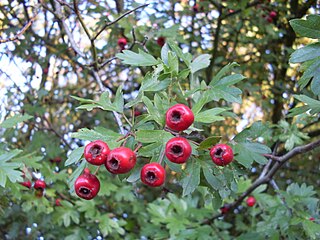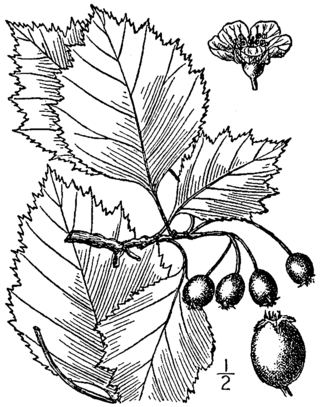
Crataegus, commonly called hawthorn, quickthorn, thornapple, May-tree, whitethorn, Mayflower or hawberry, is a genus of several hundred species of shrubs and trees in the family Rosaceae, native to temperate regions of the Northern Hemisphere in Europe, Asia, North Africa and North America. The name "hawthorn" was originally applied to the species native to northern Europe, especially the common hawthorn C. monogyna, and the unmodified name is often so used in Britain and Ireland. The name is now also applied to the entire genus and to the related Asian genus Rhaphiolepis.

Crataegus monogyna, known as common hawthorn, one-seed hawthorn, or single-seeded hawthorn, is a species of flowering plant in the rose family Rosaceae. It is native to Europe, northwestern Africa, and West Asia, but has been introduced in many other parts of the world.

Cornus sanguinea, the common dogwood or bloody dogwood, is a species of dogwood native to most of Europe and western Asia, from England and central Scotland east to the Caspian Sea. It is widely grown as an ornamental plant.

Crataegus heterophylla, known as the various-leaved hawthorn, is of uncertain origin. Its original native range is not known, possibly it was the Caucasus of Western Asia. Suggestions that it originated in Southeast Europe may be based on misidentification.

Crataegus laevigata, known as the Midland hawthorn, English hawthorn, woodland hawthorn, or mayflower, is a species of hawthorn native to western and central Europe, from Great Britain and Spain east to the Czech Republic and Hungary. It is also present in North Africa. The species name is sometimes spelt C. levigata, but the original orthography is C. lævigata.

Crataegus douglasii is a North American species of hawthorn known by the common names black hawthorn and Douglas' thornapple. It is most abundant in the Pacific Northwest.

Crataegus phaenopyrum is a species of hawthorn commonly known as Washington hawthorn or Washington thorn. It is widely grown as an ornamental plant, and can reach 10 m in height. The small red berry-like fruit grow closely together in large clusters and are food for squirrels and birds. They have a mild flavor and can be eaten raw or cooked. As with other species of hawthorn, the wood is hard and can be used to make tools.
Crataegus brachyacantha is one of the "black-fruited" species of hawthorn, but it is only very distantly related to the other black-fruited species such as C. douglasii or C. nigra. The common names blueberry haw and blueberry hawthorn refer to the appearance of the fruit, which are almost blue, and does not refer to their taste. The species is rarely cultivated but has ornamental leaves, flowers, and foliage. It is native to Louisiana, and also occurs just across the border of neighbouring states.

Crataegus crus-galli is a species of hawthorn known by the common names cockspur hawthorn and cockspur thorn. It is native to eastern North America from Ontario to Texas to Florida, and it is widely used in horticulture. It is thought to be the parent, along with Crataegus succulenta, of the tetraploid species Crataegus persimilis.

Crataegus dahurica is a species of hawthorn native to northeastern Asia. It is closely related to C. sanguinea. The fruit are red or yellow.

Crataegus macrosperma, the bigfruit hawthorn is a species of hawthorn native to most of the eastern United States and adjacent Canada, though uncommon at lower altitudes in the south. It is sometimes misidentified as C. flabellata. It is one of the earliest hawthorns to bloom in spring.

Crataegus marshallii is a species of hawthorn known by the common name parsley hawthorn. It is native to the southeastern United States.

Crataegus punctata is a species of hawthorn known by the common names dotted hawthorn or white haw that is native to most of the eastern United States and eastern Canada. While some sources claim it is the state flower of Missouri, the actual legislation does not identify an exact species. Furthermore, the Missouri Department of Conservation asserts the Crataegus mollis was specifically designated as the state flower.

Crataegus spathulata is a species of hawthorn known by the common name littlehip hawthorn. It is native to the southeastern United States. It has very attractive small delicate leaves with a bluish appearance, pretty flowers and small orange to red fruit.

Crataegus succulenta is a species of hawthorn known by the common names fleshy hawthorn, succulent hawthorn, and round-fruited cockspurthorn. It is "the most wide-ranging hawthorn in North America", native to much of southern Canada, and the United States as far south as Arizona, New Mexico, Kansas, Missouri, North Carolina, and Tennessee. In this wide area there are many variant forms that have received species names, but can also be considered as synonyms. It is thought to be the parent, along with Crataegus crus-galli, of the tetraploid species Crataegus persimilis.

Crataegus uniflora is a species of hawthorn known by the common name one-flowered hawthorn, or dwarf hawthorn. It is native to parts of the southeastern United States. The plant is usually a small bush, but some forms can be a few meters tall. The flowers occur singly or in small clusters. The fruit are hairy and yellow to reddish in colour.

Crataegus mexicana is a species of hawthorn known by the common names tejocote, manzanita, tejocotera and Mexican hawthorn. It is native to the mountains of Mexico and parts of Guatemala, and has been introduced in the Andes. The fruit of this species is one of the most useful among hawthorns.

Crataegus songarica is an Asian species of hawthorn with black fruit that is sometimes used medicinally. It is closely related to Crataegus ambigua, a species that has red fruit.

Crataegus brainerdii is a species of flowering plant in the rose family known by the common name Brainerd's hawthorn. It is named for Ezra Brainerd (1844–1924), a renowned botanist and former president of Middlebury College, in Vermont.

Series Molles is a series within the genus Crataegus that contains at least six species of hawthorn trees and shrubs, native to Eastern North America. Some of the species are cultivated as ornamental plants. They have relatively large leaves, large flowers, and bloom early for hawthorns. The plant parts are usually hairy, particularly in early growth, and the fruit are generally red and are large for hawthorn fruit.



















